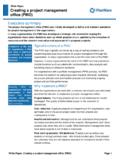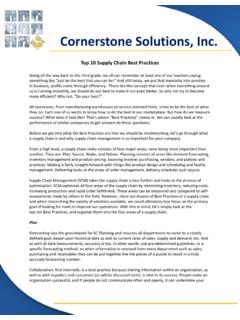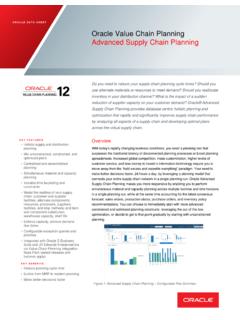Transcription of PRINCIPLES ANDTECHNIQUES OF MANAGING …
1 WORLD HEALTH. ORGANIZATION. MINISTRY OF HEALTH. GHANA. EUROPEAN UNION. PRINCIPLES AND TECHNIQUES. OF MANAGING inventory . Training Manual PRINCIPLES AND TECHNIQUES OF MANAGING inventory . PRINCIPLES AND TECHNIQUES. OF. MANAGING inventory . Training Manual Pharmacy Unit (GHS) & Procurement & Supplies Directorate (Moh). October 2008. Funding Organization: i PRINCIPLES AND TECHNIQUES OF MANAGING inventory . TABLE OF CONTENTS. Part 1. A. General PRINCIPLES and Techniques of MANAGING inventory Section 1 Introduction to inventory supervision ..3-6. Section 2 Classification of demand ..7-9. Section 3 Profile of demand ..10-11. Section 4 Forecasting ..12-18. Section 5 Establishing when to order ..19-22. Section 6 Establishing re-order quantity ..23-26. Section 7 Stock evaluation & performance measurement 27-45. B. Logistic Management of Moh/GHS..46-53. ii PRINCIPLES AND TECHNIQUES OF MANAGING inventory . MINISTRY OF HEALTH. GHANA. ACKNOWLEDGEMENTS. This document has been produced with financial assistance of the European Commission through the World Health Organization and the WHO country office for Ghana.
2 The views expressed herein are those of the authors and can therefore in no way be taken to reflect the official opinion of the European Commission EUROPEAN UNION. The Contributors To This Publication The following personalities contributed to the development of this training manual;. Mr. J. O. Kyei Chief Pharmacist, Ghana Health Service Mr. Samuel Boateng Director, Procurement and Supplies, MOH. Mr. Peter Gyimah Head, Central Medical Stores, Tema, MOH. Mr. James Benjamin Annan Project Coordinator, LMIS, MOH. Special Thanks to: Mrs. Edith Andrews Annan Professional Officer, Essential Drugs and Medicines Policy, World Health Organization iii PRINCIPLES AND TECHNIQUES OF MANAGING inventory . Part 1. SECTION 1. INTRODUCTION TO inventory SUPERVISION. Inventories are a major component of any logistics system and as such require to be planned, managed and controlled in order to achieve the basic aims of:- Minimising costs at acceptable levels of investment.
3 Providing the desired levels of customer service. Their purpose includes:- The decoupling of supply and demand through the creation of buffer stocks. The build up of anticipation stocks to meet planned or expected demand. inventory management needs to recognise it cannot work in isolation within the logistics system. It can have a significant effect, through the inventory policies it employs, on many of the inter-related activities, for example; distribution networks, warehouse design and operation, inward and outward bound transport, and should be capable of identifying these areas of cost trade-off which will optimise the efficiency of the total operation. OBJECTIVES. In the development of an inventory system to achieve the two 1. PRINCIPLES AND TECHNIQUES OF MANAGING inventory . basic functional objectives related to investment cost and service level, the control process should be designed to:- i. Express the policies in quantitative terms to achieve consistency of operation.
4 Ii. Adopt the simplest effective mathematical techniques to ensure that routine calculations can be easily performed. iii. Provide decision rules in quantitative terms that will trigger inventory control response. iv. Provide for exception reporting of non-routine situations promptly. v. Provide appropriate levels of information to be available to challenge, and where appropriate, override system decisions. RESPONSIBILITIES AND ACCOUNTABILITIES. The major responsibility of inventory management is the management of materials and materials systems throughout the defined acquisition and supply chain from procurement to consumption point. As a result of this responsibility, inventory management is accountable for the physical and financial levels of stockholding, the service level provided to customers, the control parameters within the inventory system and all the decision related processes in the total operation. In addition inventory management is responsible for:- 2.
5 PRINCIPLES AND TECHNIQUES OF MANAGING inventory . i. Controlling each individual item, through its acknowledged characteristics, on a day to day basis. the effective use of personnel involved in the management process. iii. Providing information and feedback on the effectiveness of the inventory system. STRATEGY, PLANNING AND OPERATIONAL CONTROL. REQUIREMENTS. inventory management is largely looked upon as a day to day operation concerned with meeting specified short term targets. It does, however, have a major role to play in the short, medium and long term developments of an organisation and should be an integral part of the business planning cycle. STRATEGIC REQUIREMENTS. Awareness of the expected development of the business in terms of future production, suppliers, customers, volumes etc. are all essential to enable inventory management to make recommendations, measure the impact and plan the necessary actions to meet the long term requirements.
6 Decisions on what product lines to stock, where to stock them and the form of the distribution network, to achieve the continuing optimisation of investment cost and service level is an on-going process in which inventory management needs to be involved. 3. PRINCIPLES AND TECHNIQUES OF MANAGING inventory . PLANNING REQUIREMENTS. Most inventory planning cycles follow the business planning cycle based on a one year time frame. Information on the expected changes in such factors as seasonality, volumes, supplier lead times, required service levels, product and operational costs, and special requirements, within the medium term time frame need to be available to inventory management with sufficient lead time to establish and implement any changes to the processes and/or control of the inventory system. OPERATIONAL REQUIREMENTS. These refer specifically to those elements which create, in the short term, constraints or opportunities within the inventory process.
7 They are generally concerned with specific action taken or which are required to be taken to meet changes in the levels or form of activities not previously identified within the medium term planning cycle. CONTROL REQUIREMENTS. In most inventory systems, the parameters and controls that determine the key triggers which result in the levels of inventory held on a line by line basis are not always capable of being responsive quickly enough to meet unexpected short term variations and this stage inventory management may see fit to intervene. It is essential that inventory management, at such times, have available sufficient data and information, in a usable form, to 4. PRINCIPLES AND TECHNIQUES OF MANAGING inventory . apply alternative decision making processes to maintain the inventory system effectiveness. In doing so the consistency of decision making is a major objective in achieving the alternative course of action. BASIC CONCEPTS OF inventory CONTROL.
8 A typical example of the cycle of events, over time, of any item is often referred to as the Stock-Time Curve. It identifies the results of:- The pattern of stock carried resulting from the supply and demand activity. (The complete curve). The time of receipt of supplies (TS) and the quantity received. (Q). The point in time when orders should be placed. (ROL). The average stock carried. (SS + Q/2). The stock held against uncertainty and variability of demand. (SS). The point in time when stock outs occur. (SO). COMPONENTS OF inventory . The four basis components of inventory can be identified as being:- i. REPLENISHMENT OR CYCLE STOCK. This is the stock resulting from the ordering policies and is ed. 5. PRINCIPLES AND TECHNIQUES OF MANAGING inventory . determined by the frequency of ordering and the quantity ordered. ii. SAFETY OR BUFFER STOCK. This is the stock held for protection against the uncertainty of demand and, where applicable also of supply.
9 Iii. ANTICIPATION OR INVESTMENT STOCK. This is the stock procured in advance of requirement: schedules; planned requirements such as, product launches, promotions; seasonal demands; purchases to take advantage of market exploitation. iv. MOVEMENT OR TRANSIT STOCK. This is stock which is in transit between suppliers and customers and can be separately identified. The day to day control of inventory is through the management of the Stock-Time Curve to achieve the optimum cost and service equation. 6. PRINCIPLES AND TECHNIQUES OF MANAGING inventory . SECTION 2. CLASSIFICATION OF DEMAND. Whilst recognising that each item within the inventory system identified by its description and/or item code, has its own individual set of characteristics, it would not be possible to devise a different set of processes and controls for each item. Conversely, in establishing an inventory system for a range of widely different items it can be clearly seen that no system of control can be applied to the whole range.
10 It is necessary, therefore, to have a process for classifying items into groups or types to enable the relevant system, to satisfy the investment cost and service level objectives, to be identified and applied. In reviewing the item range in any inventory system, therefore, some or all of the following elements need to be considered in assisting to predetermine the system to be applied. RANDOM/PREDICTIVE DEMAND. This initial item classification is usually carried out by firstly identifying any item which has a predictive demand. By process of elimination the remainder of the item range will be classified as having a random demand. It is necessary to set precise rules for the identification of predictive demand items. In this context predictive relates only to those items which have a quantity and time commitment for when they will be 7. PRINCIPLES AND TECHNIQUES OF MANAGING inventory . required. These would include:- v Items which are called off on a schedule basis by a customer with no deviation in quantity or time against the original forecast.















